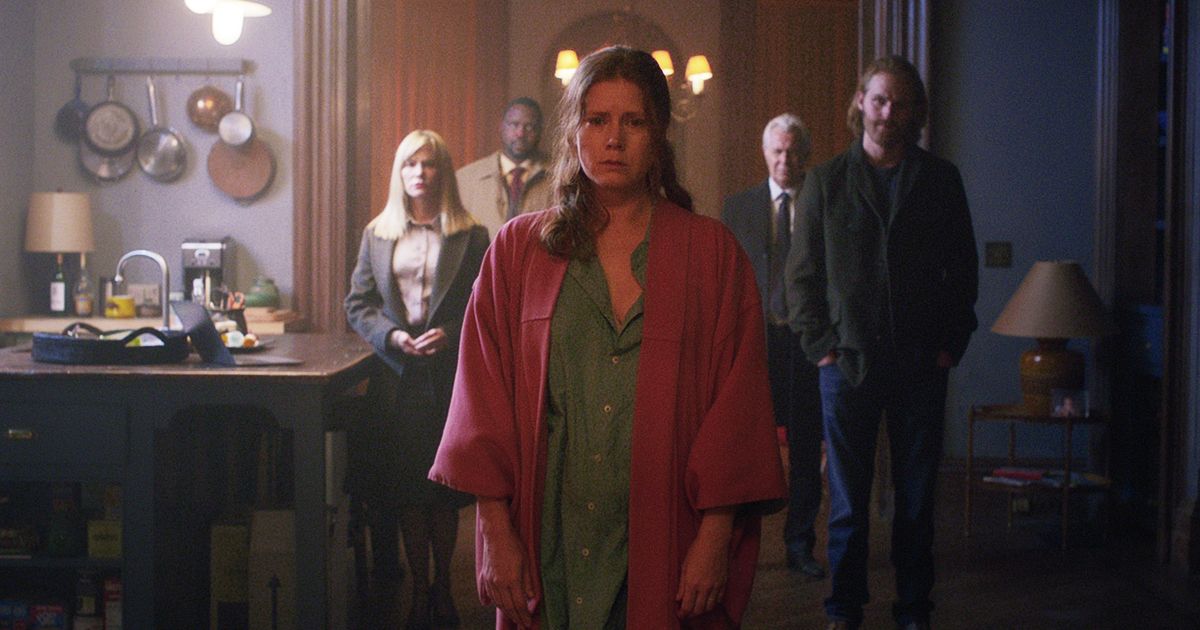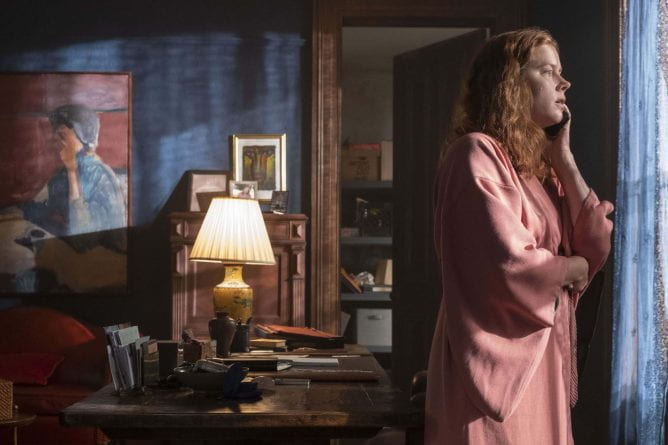Ms. Amy Adams, you are our underdog. Nominated for six Academy Awards, most followers of film agree that she is long overdue an Oscar. She is endlessly charming, and morphs into wildly different roles, from the quiet power of Peggy in The Master to the comfortable relatability of the titular Julie in Julie & Julia. To quote the kids, she has the range! It is frustrating that her most recent releases are films like Hillbilly Elegy and now The Woman in the Window. The Woman in the Window follows an agoraphobic child psychologist living in New York City who spies on her neighbors, Rear Window-style. Stuffed with Oscar talent and helmed by two critically acclaimed filmmakers, director Joe Wright– the man who directed the hand-flex scene in 2005’s Pride & Prejudice– and everyone’s favorite dad, writer Tracey Letts; this film struggles to find meaning in its peering.
I have a soft spot for films that reference old Hollywood. This film makes liberal use of these references throughout the first half of our story– of course completely dropping it by the middle. The first reference is a small moment in which Anna (Amy Adams) lends some of her DVDs to her 16-year-old neighbor Ethan (Fred Hechinger), and in his arms is Gaslight (1944). It is a small, unintentionally hilarious moment. The film Gaslight is where the term– meaning psychological manipulation involving distorting the truth in order to confuse or instill doubt in another person to the point they question their sanity or reality– originated from. Thankfully, the only way you can see this DVD cover is if you did what I did, which is literally pause the movie for a split-second glimpse. It is hilarious because there is just so little nuance to the inclusion. In addition, Julianne Moore’s character is named Jane Russell (at least for the first half, but no spoilers!). When Anna searches up Jane Russell’s name, a classic film star pops up– Jane Russell of Gentlemen Prefer Blondes and numerous other studio system classics. Why name Moore’s character this? I can find no correlation despite the film presenting this connection to the audience.

On the other hand, the use of Laura (1944) and Spellbound (1945) are incorporated much more smoothly. Anna drunkenly laughs to Laura, the dialogue of the film perhaps reflecting her view of herself. One of the most iconic scenes of Spellbound, the Salvador Dalí dream sequence, plays in the background with Anna’s eyes in the foreground, illustrating her hazy, dream-like state of mind. The final classic film reference is a scene from Dark Passage (1947), in which Humphrey Bogart is put under. It illustrates virtually the same feeling as the Spellbound reference and is even shot almost exactly the same. These references add rather than detract from the film, but they illustrate a problem this film has. The focus on the visual often detracts from important interiority elements of our protagonist.
The Woman in the Window is a wonderfully shot film. The color grading is beautiful, full of hazy warm tones. Pink light pours into Anna’s bedroom, filtered through curtains. Shadows and light reflect off of Anna’s face as she peers into the outside world. Visual moments like a repeating image that appears in Anna’s sleep are compelling. This is not to say the film is perfect in regard to its images, there is a strange slasher-esque angle the film takes during moments of violence that is tonally uneven with the overall visual language. The filmmakers sometimes overuse the dutch angle, and one moment of Anna in a rocking chair is a bit too on the nose. Anna’s last lines are poorly shot as well, and one can’t help but wonder what scenes were the result of the reported reshoots. The production design of this apartment is visually gorgeous. It is clear that kind of woman who lives in an old brownstone like this would have a taste for classic films. There’s a warmth to the apartment, which is interesting regarding Anna’s phobia of leaving her apartment. One question that I found myself wondering while watching this was, why is the apartment so spacious? Is it due to this apartment being Anna’s entire world? The reasoning is vague, and I have a feeling it has more to do with blocking.

It is clear when viewing The Woman in the Window that the problem is not necessarily the visual image– even if it is a little uneven at moments. It is not the cast– in fact, talent like Jennifer Jason Leigh and Tracey Letts are arguably underused. Amy Adams is wonderful in her pacing during two monologues. Gary Oldman plays such an unlikeable character so well, and Julianne Moore plays her character with a secret stirring just below the surface. None of these players are at the top of their game, but their performances are nothing to be ashamed of. The screenplay is the source of so many issues with this film. To begin with the moments that worked well, Anna’s relationship to her phone is well incorporated into the film. She views it as a security blanket, and the payoff in terms of this relationship is well done. There is an intense moment with Gary Oldman that throws the audience off in terms of the overall mystery, but not in a manner that throws off the plot of the film. Tension is inherently built into the film, in that the viewer can’t help but wonder when will Anna’s neighbors catch her spying? So much of this film revolves around photography. One photo of Anna is a great twist, and another integral photo represents a decent (if a bit obvious) set-up and pay-off. But– the film never questions the deeper meanings behind taking a photo.
What does it mean when you take someone’s photo? What does it mean for that person’s privacy or sense of self? The film never answers any deeper questions in regard to the interiority of our protagonist. What motivates Anna to look at her neighbors before she gets mixed up with this act of violence? It is one of the first things we learn about Anna, but so little is examined in regard to this huge framing device for the film. In fact, we never get a straight answer as to why she has agoraphobia. We know Anna suffers from mental illness(es), but we never get a straight answer as to why her mental illness(es) result in this form of anxiety appearing. The film attempts to answer this with the first big reveal of the latter half of the film, but it’s not the straight answer the filmmakers think it is. In addition to these deeper questions the film fails to consider– or at the very least address– the screenwriting has a clear over-explaining problem. A messy twist is the worst aspect of this film, to the point where it cheapens the overall project. The Woman in the Window takes stylistic cues from classic films but fails to deliver on any of the nuance and deeper meanings that these filmmakers captured. Just watch Rear Window instead.
2/5 STARS
